

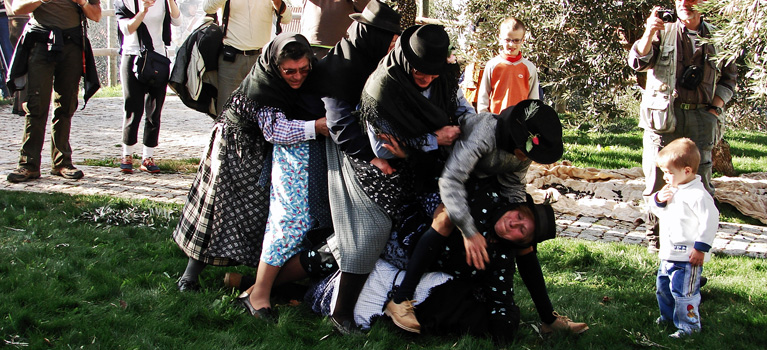



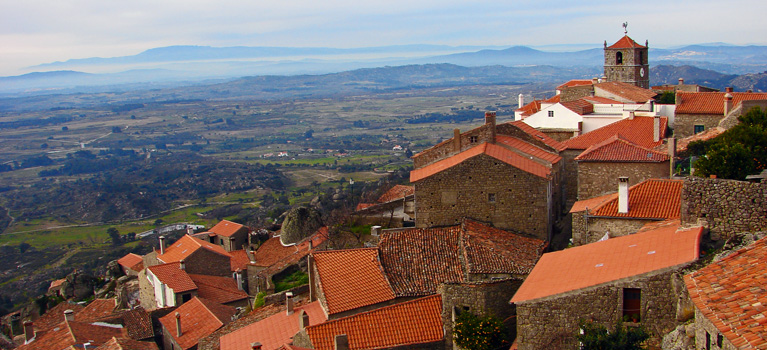
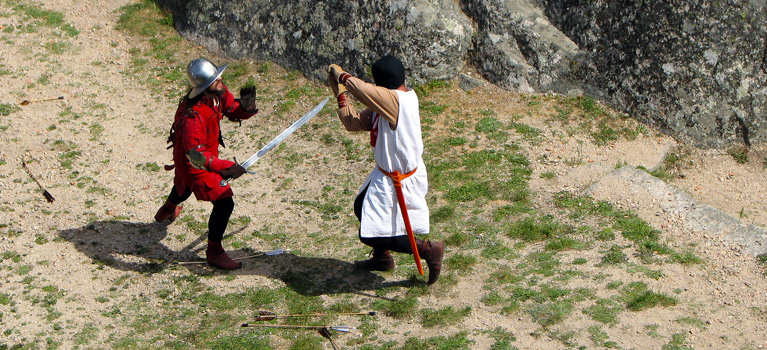
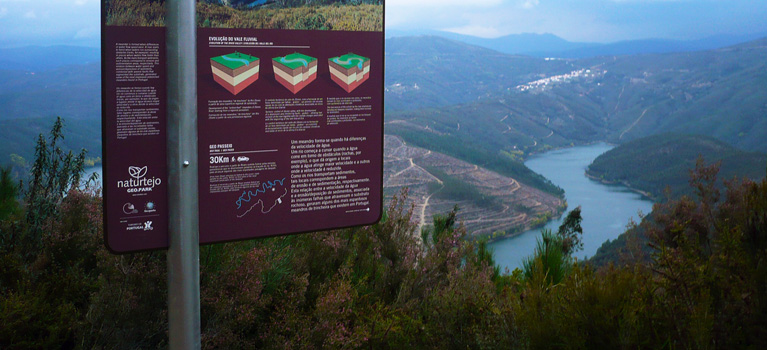

Two of the ten villages distinguished as Historic Villages belong to the territory of the Geopark: Monsanto and Idanha-a-Velha and they are both located in the Idanha-a-Nova region.
Idanha-a-Velha Historical Village (Idanha-a-Nova)

It was once the rich roman city of Civitas Aegitidanorum (documented since the year 16 b.C.), it is one of the main references to archaeological routes in Portugal. Moreover, the history of Idanha-a-Velha is filled with tales from ancient times, from Visigoths and Arabs, to medieval knights, Templars and landlords, who left their inscriptions on this territory.
There is a vast patrimony were the Visigoth Cathedral (built on top of paleochristian temple), with a baptistery and an outdoor pool, still impresses today for its richness and dimension. Nowadays, it holds one of the most important epigraphic collections regarding roman occupation of the peninsula.
The Walls and the Donjon Tower were rebuilt during the medieval era, keeping the people safe within its perimeter. The squared tower is based on the remains of a roman temple.
Other attractions: “Porta” and Roman Bridge over the Ponsul, Pillory (16th century), S. Dâmaso Chapel (18th century), Egitaniense Museum.
Cartier Replica Watches www.uwswing.com
For more information: www.aldeiashistoricasdeportugal.com
Monsanto Historical Village (Idanha-a-Nova)
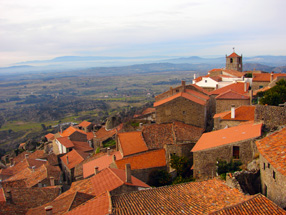
This village received, in 1938, the title of “The most Portuguese village in Portugal”. The majestic medieval castle of Monsanto was partially destroyed due to an accidental explosion on a Christmas Eve, in the 19th century. Today two towers remain – the Peão (Pawn) tower and the Donjon tower – and the Romanic chapel of S. Miguel (12th century).
This village is also known for the traditional percussion instruments, the “adufes”, and the traditional rag dolls, the “marafonas”. The “adufes” are an instrument with Arab origins, made with sheep skin.
The “marafonas” are rag dolls with no eyes, ears, mouth or nose, and are carried by single girls during the Nossa Senhora do Castelo Festivities (3rd of May or the Sunday afterwards).
For more information: www.aldeiashistoricasdeportugal.com
With a picturesque aspect, these villages are an agglomeration of traditional constructions built in schist. They are spread all across the Geopark’s territory being found in the territories of Proença-a-Nova (Aldeia da Figueira), Oleiros (Vila de Álvaro), Vila Velha de Ródão (Foz do Cobrão) and to the west of Castelo Branco (Sarzedas and Martim Branco). These villages are usually located on steeped hills, merging in the landscape. These are sites with a magic of their own, with their value residing on the simple characteristics of the architecture, in villages of narrow and peaceful streets in which we are invited to roam.
Martim Branco (Castelo Branco)

By the backdoors of the last street of this village, the Almaceda river makes the birds and water sing. Outside, the community oven still exhales the smell of freshly baked bread. The ovens are the most interesting element in Martim Branco, and their recovery has brought a new life to this community. You just got to taste the bread to understand why.
In a difficult terrain, of up and down streets, wide here, narrow there, it is this kind of landscape, harsh and gentle, where bushes stubbornly grow, that Martim Branco lives. Walls of schist, that once divided properties, now unify the identity of the village. Some houses also testify the marriage between schist and granite, materials which assure the buildings’ quality and longevity. The doors are usually beautiful crafted iron.
It is like this village stopped in time. Between the schist and the quartz, the type of construction is humble and genuine, characteristics that time didn’t erase.
For more information access: www.aldeiasdoxisto.pt

This village, once head its own municipality, is characterized by the distinctive color of the plastered walls. The streets’ dimensions and of its constructions, such as the pillory, the Church and the Chapels, testify the history of this village and of its inhabitants.
From the top of the hill of S. Jacinto, right in front of the church, rises the bell tower – the remains of the old Outeiro church. This is a very pleasant space, which we owe the construction to D. Gil Sanches.
For more information access: www.aldeiasdoxisto.pt
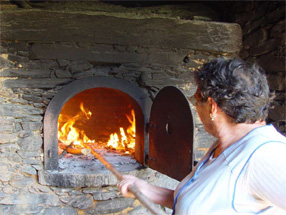
This is a very typical village, where everybody exchanges greetings, where chickens and goats wander, the wagons still transport hay, and the community oven still smells like freshly baked bread.
This village’s environment is still pretty much rural, in spite of its proximity to the IC8 roadway, the Moitas’ airdrome and the parachute school, the “Ciência Viva da Floresta” center, the Horse-riding school, and the Fróia’s river beach, which constitute the main touristic attractions in this region.
For more information access: www.aldeiasdoxisto.pt
Foz do Cobrão (Vila Velha Ródão)

One of the Ocreza river tributaries is the Cobrão river. It was by the banks of this river, that a human settlement prospered for centuries. Nowadays, this village is characterized by its architecture, with white plastered houses that suggest the proximity to the Alto Alentejo region. The quartz formations of the Sarnadas hill are home to griffins and black storks, which contemplate the 500 million year old fossils from above.
In this landscape, the natural elements merge, sculpted by an ancient ocean combined with men’s mastery, who imposed their crops on these formations. The construction of terraces is one of the most distinctive elements in this region, making this one of the best territories to the production of olive oil.
This is a territory where traditions still matter, in which one of the most interesting practices is still the discovery of gold in the Ocreza or in the Cobrão rivers. Come and find a gold nugget.
For more information access: www.aldeiasdoxisto.pt
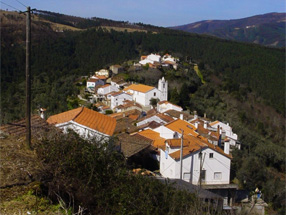
This village spreads along the banks of the Zêzere river, accommodated by the Cabril dam. Seen from the top of the mountains that surround it, it looks like a white wall that guards the river. This is one of the “white villages” of the Schist Villages Network, in which the base material, the schist, is complemented by the plastered walls, an indication of a wealthy past and economic importance.
Its rich religious patrimony testifies this village’s past importance to religious orders. Here we can find, in some constructions, the cross of Malta.
The Misericórdia Church is one of the sites which also deserves a visit, but not before one knows the Chapels’ circuit. In these spaces you’ll find important manifestations of faith, through religious art, from paintings to singular artifacts, such as a sanctuary from the Renaissance.
For more information access: www.aldeiasdoxisto.pt
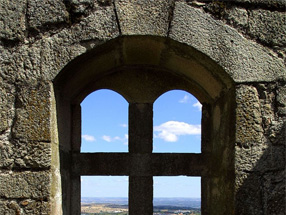
AAFrom the primitive templar castle, from the beginning of the 13th century, little remains. Its position, near the border, led to its participation in successive battles, which greatly damaged this structure.
Within this enclosure we can still find the Santa Maria do Castelo church, an old parish. It was in this churchyard where the Good Men council, the monastic and the military authorities came to meet until the 14th century. This church was almost destroyed during the Spanish invasions, after the Portuguese revolution against the Spanish rulers in 1640, and in 1704 it was again set on fire by the Spanish. The French also contributed to the degradation of this church, using it as a stable and setting it on fire during Junot’s invasion of Portugal.
Below this church, we can find several tombs, among which the tomb of João Roiz de Castelo Branco, a famous 16th century poet.
The entrance to the fortress is through a round arc, where we can also find a primitive cistern. Right in front of this arc, we can find the Templar tower, with ornamented windows with Manueline elements, where once the Palace was located.

The Idanha-a-Nova village was founded in the last quarter of the 12th century, by the illustrious master of the Templar order D. Gualdim Pais, who held this territory as one of the boundaries of the uprising nationality.
Idanha-a-Velha Walls (Idanha-a-Nova)

The Idanha-a-Velha castle is, in fact, just a tower, also designated as Templar tower, which was built by this religious order in a territory given to them by the first king of Portugal, D. Afonso Henriques. This castle, with little to describe, belongs to one of the first villages in Portugal, with a much larger archaeological and architectonic patrimony, protected as National Monument.
The excavations that took place, mainly after 1955, by the archeologists Fernando Almeida and Veiga Ferreira, led to the discovery of a true village-museum, with one of the richest collections in the country.
The first forms of human occupation in this region are due to at least, the roman occupation of the Iberian Peninsula, since about the 2nd century, with a well structured fortification. The Suebic and Visigothic cultures also occupied this area, renaming it Egitânea, being then conquered by the Arabs.
D. Afonso Henriques finally conquered the village to the Portuguese kingdom in 1160, attributing its administration to the Order of the Temple, who built Idanha-a-Velha’s donjon tower and the Castle of Idanha, around 1197.
Monsanto Castle (Idanha-a-Nova)
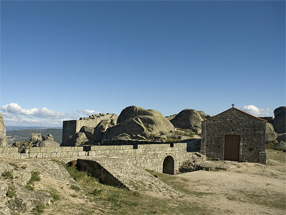
Monsanto is a village located in the Idanha-a-Nova municipality in the territory of a once important roman settlement. Its castle was built during the first quarter of the 13th century. In 1658, the Spanish surrounded Monsanto, but this campaign was unsuccessful. In 1704 the Spanish army, under the command of D. Francisco Rouquilhos, was again defeated by a small Portuguese battalion under the command of Marquez das Minas. At that time, Monsanto was still an important fortification, with
notable military value.
With the downfall of the population, the fortification lost its importance, and began to deteriorate. However, this is still one of the most important fortifications in Portuguese history, symbol of the formation of our nationality.
The festivities of Nossa Senhora do Castelo celebrated on the Sunday of the 3rd of May (or in the next Sunday), are a pagan tradition, with the traditional throwing of the calf, symbolized by the clay pot ornamented with sylvan flowers. These festivities celebrate the legends of this people victories and the pride in their cultural identity.
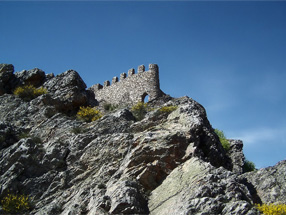
This castle was most probably constructed by the Templars, on top of a roman fortification preceded by a prehistoric hill fort. Even so, the castle might also have been constructed during D. Sancho I reign, and then donated to the Order of Santiago, around 1220. After that, these domains were transferred to the possession of the Order of the Temple, by D. Dinis in the 14th century, and finally returned to the hands of the crown, in the 16th century. By the end of the 19th century, this military building began deteriorating, but its walls are still well preserved today, in spite of not being recognized by any classification.
This castle is also connected to the legend of the kidnapping of the daughter of the governor of Monsanto, D. Branca, by the “alcaide” (a kind of mayor) of Penha Garcia, D. Garcia. According to this legend, he would eventually be captured by the governor of Monsanto and sentenced to death. However, D. Branca begged for his forgiveness and instead of killing him, the governor only chopped off one of his arms. According to the legend, the “alcaide” still haunts the castle.
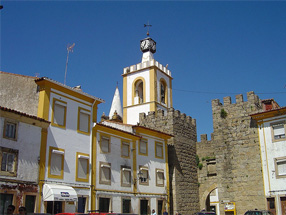
The castle of Nisa was built by D. Dinis around 1290, with the help of the Order of the Temple, after his brother D. Afonso Santos destroyed the old castle, as retaliation for this people’s refusal in supporting his ambitions to the throne.
D. Afonso IV, in 1343, also ordered the defenses of this village to be strengthened, and with the beginning of the Interregnum crisis in 1383, the village became famous.
The defensive complex of Nisa was badly damaged during the war with Spain, whose forces occupied the village in 1704. The destruction would not be mitigated, for urban development would be a factor of pressure during the next century.
The remains of the castle are protected as a National Monument, contemplating the donjon tower and fragments of the castle walls.
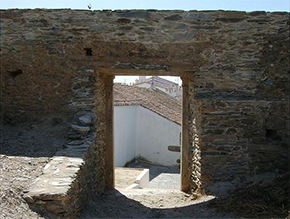
This castle is very close to the border with Spain. It is in a state of ruins, but we can still find some remains of the castle’s foundations, its towers and cistern, on the top of a privileged viewpoint, with unparalleled landscapes.
There are no certainties about the construction of this castle, but it is certain that it dates back to the Christian Reconquista of the peninsula, integrating the famous Tagus defensive line, rebuilt by D. Dinis by the end of the 13th century.
Because this is a region of low population density, but of a great strategic importance for the defense of the frontiers, this was never a magnificent castle, but had some defensive importance as a medieval fortification. With the loss of this importance, the castle thus began to deteriorate.
Its main gate dates back to the 17th century and we now know the castle belonged to the Order of Christ. The castle square has also served as a cattle refuge for the population.
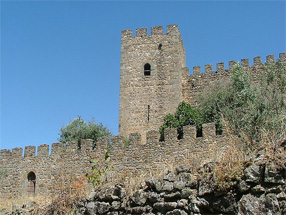
This castle was probably built during the kingdom of Afonso IV, around 1350, by the Order of Saint John, to whom Sancho II donated these lands.
In 1440, D. Pedro recovered this territory, given the fact that the prior of this order was a supporter of D. Leonor de Aragão, and the armies of Castile.
The earthquake in 1755 badly damaged the castle, and some restoration interventions were made. However this monument was not protected until the mid-20th century, and only than it received significant intervention.
Rei Wamba Castle Runis (Vila Velha de Ródão)

Although traditionally its construction is attributed to the last great Visigoth king Wamba (672-680), the castle may have been built during the Arab occupation of the peninsula.
During the Christian Reconquista of the peninsula, in the context of the affirmation of Portugal as an independent state during the 12th century, this structure was rebuilt, probably by the Order of the Temple, around the same time that Nossa Senhora chapel was built. This building is a lookout tower, on a scarp over the Tagus’ waters where we can see the natural moment of Ródão squeezing the river. On the top of these walls, the visitor unveils a magnificent view over the valley.
Since 1993, this monumental complex is considered of Public Interest, and since 1998 the association dedicated to the study of this region, as well as the municipality of Vila Velha de Ródão, lead the development of an ambitious project that aims to requalify this patrimony.
The Castle and Urban Wall are classified as a National Monument, being part of the Beira border defence line. The medieval urban settlement, still perceptible along Rua de São Pedro, was surrounded by a defensive belt that, during the Wars of Restoration, was reinforced and six bastions were built around the previous medieval fortification. Despite the process of destruction and dismantling that began in the 19th century, Penamacor Castle, understood as the entire walled area of the old medieval town, retains significant relevance in heritage terms.
In the Tower of Menagem - Castle Interpretation Centre there are information panels about the historical evolution of the municipality, a scale model of the old fortification and a showcase that gathers some of the objects discovered during the archaeological excavations carried out in recent years.
Everywhere across the Geopark Naturtejo, even in the tiniest villages, we can find outstanding religious monuments, some great, some humble. Many of them with a long existence, going back to the dawn of Christianity, as in the examples of the Cathedral of Idanha-a-Velha, built more than a thousand years ago.
The evolution of architecture is well mirrored in these constructions. The simplicity of the Romanic, evidenced on the chapels of S. Miguel and of S. Pedro in Monsanto, gave place to the refined aesthetics of the Gothic that can be seen on the chapels of N. Sra. De Mércoles, in Castelo Branco, N. Sra. Da Alagada in Ródão, or N. Sra. Da Graça in Nisa.
The S. Miguel church, originally of medieval trace, would suffer many changes through the centuries, where Baroque and Rococo elements are now the main manifestations of art.
With the creation of the bishop’s district (diocese) of Castelo Branco, in 1771, to the church of S. Miguel was attributed the designation of cathedral. The main chapel and the altarpiece date back to 1785. In 1791, Pedro Alexandrino also enriched the Santíssimo chapel and the altarpiece with work of his own.
From the main front, stands out the picture of S. Miguel.
N. Sra. de Mércules Hermitage(Castelo Branco)
This chapel, dedicated to N. Sra. De Mércoles, is 3km distant from Castelo Branco, and it was built by the Order of the Temple around the 12th century, the rulers of this region at that time.
In the beginning, this chapel only had one squared nave, but it suffered some modifications such as the painted wooden ceiling, the windows, the white and blue tiled walls and the construction of a sacristy. Currently, the chapel has three ogival entrances, with Romanic and Gothic elements. The pavement of the chapel is located below the rest of the terrain, and because of that there is an access staircase.
To its side, the chapel has a house, which used to be a shelter for pilgrims who came from distant lands, but it is now home to the chapel’s guardian.
N. Sra. De Mércoles cult is a mix of legend, paganism and Christianity, a fact that may explain why this hermitage has so many overlapped elements.
Cathedral of Idanha-a-Velha (Idanha-a-Nova)
This cathedral is a building that’s worth for itself. However, it lacks some of the equipments to the realization of ludic and pedagogic activities, such as archaeological or religious exhibitions. The cathedral and the surrounding ruins are a main attraction within the architectonic complex. Built on top of a paleochristian temple, it was afterwards a Visigoth basilica. Nowadays, it holds one of the most important epigraphic collections, concerning roman occupation. There is also a singular ogival lateral entrance and a collection of frescos worth of attention.
Parochial Church of Proença-a-Velha (Idanha-a-Nova)
The main church of Proença-a-Velha or Nossa Senhora da Silva church is a Baroque construction. After some modifications in 1764 it received its altarpiece in gild, and its main chapel possesses ornamented stonework, with representations of the crucifix, of Mary and of S. João. This church and its /images are distinguished as a Public Interest Building since the year 2002.
Parochial Church of Salvaterra do Extremo (Idanha-a-Nova)
This church was probably built around the 15th century, and it has a longitudinal configuration with a nave, a main chapel, a sacristy and a bell tower. Inside the church there is also a beautiful altarpiece in gild.
Igreja Paroquial deParochial Church of Idanha-a-Nova
This church was rebuilt in the 16th century on top of a medieval temple. Its characteristics resemble the Renaissance style, although there were subsequent interventions. The patroness image was there placed during the 17th century and its entrances replaced in the 18th century. It’s protected as a Building of Public Interest.
Romanic Chapel of S. Miguel (Monsanto, Idanha-a-Nova)
This is the most important chapel of Monsanto, dating back to the 12th century. It is located between the castle and the medieval watch tower, designated as the Pawns’ Tower. This chapel indicates the existence of a previous population as it was built on top of a pagan temple, were Mars was worshiped. Surrounding the chapel, there are also various tombs carved on the granite, sign of an ancient paleochristian graveyard.
S. Pedro de Vir-a-Corça Hermitage(Monsanto, Idanha-a-Nova)
Down by the base of the inselberg, far away from the village, there is a little hermitage, which is one of the best examples of the Romanic in the Beira Baixa region.
There is not much information about this temple, but some authors relate the existence of this chapel to the existence of a roman villa – “Villa Corça”. Other authors, base their theories on a legend of the existence of a hermit, Santo Amador, who according to the legend lived here centuries ago.
The building that we see today is an exemplar of a Romanic construction and dates back to the end of the 12th century. It also testifies the importance of this place to the manifestation of people’s religiosity, as well as the territory’s importance to economic vitality. This place was once home to a fair, ordered by the king D. Dinis to serve the surrounding villages.
More information: www.igespar.pt
N. Sra. da Graça Chapel (Nisa)
The Sra. Da Graça viewpoint is 3 km distant from Nisa. Located on top of the hill we find the Nossa Senhora da Graça hermitage, which dates back to the 16th century.
Nisa itself also has its origins on this hill, where an old hill fort was located. Nowadays, the patroness of Nisa is still Nossa Sra da Graça.
This is a marvelous viewpoint, from where we observe mountains and valleys where the time seems to be still. The Nossa Senhora da Graça pilgrimage is one of the most famous in this region, taking place every year on Easter Monday, attracting a large quantity of visitors.
N. Sra. dos Prazeres Hermitage (Nisa)
This is a temple from the 16th century, rebuilt on top of a previous one, probably from the 14th century. Its interior has a dome with painted beams and the Cross in its center. In its surroundings there are also two other churches which usually welcome pilgr/images on Easter days.
N. Sra. do Calvário Chapel (Amieira do Tejo, Nisa)
Located on a hill, this chapel dates back to the 18th century. It is a pilgrimage destination, where the altar piece in stonework stands out. It is protected as a Building of Public Interest.
N. Sra. da Redonda Chapel (Alpalhão, Nisa)
This church, located by the Sor River, is of great architectonic beauty. Among its elements stand out the dome, built in 1564, the altar with baroque elements and tiles from the 18th century and the red painting of the chamber’s ceiling. On its walls there are also baroque tile panels, holding great symbolic importance.
This building’s construction, dedicated to Nossa Senhora da Conceição, was concluded in 1715. Its main elements are its altar, ornamented with Hispano-Arabic tile from the 16th century, its lateral walls with figurative ceramic panels from the 18th century and the ceiling covered with wooden boxes, filled with 18th century paintings.
Contact:
Centro Paroquial de Oleiros
Telf.: +351 272 682 319
Schedule:
Weekdays and saturdays: 14h00 | 16h00
Sundays: 10h30 | 13h00
Misericórdia de Álvaro Chapel(Oleiros)
This chapel was built in the late 16th century, holding above its front entrance an image of the Lady Mary. This chapel’s main elements are its ceiling’s decorations, the Way of the Cross panels, the altar, from the early 19th century made in gild, and some oil on wood paintings, dating back to the 18th and 19th centuries.
Contact:
Santa Casa da Misericórdia de Álvaro
Telf.: +351 272 674 205
Visits: Appointments required
N. Sra. da Alagada Chapel (Vila Velha de Ródão)
This chapel is located near the river, in a small hill, and its name is due to the fact that, according to the oral traditions, its image was found inside a box were the hermitage was then built. In the honor of the saint, every year on the 4th weekend of August, there is a feast.
Surrounding this sanctuary, there are many olive trees, a manifestation of nature’s beauty.
N. Sra. do Castelo Ermitage (Vila Velha de Ródão)
This is an ancient hermitage which is thought to have been built for pagan worshiping. Others think that the construction of this site is due to the miracle of the rescuing of the fluvial fishermen, who built the sanctuary in honor of the saint.
All evidences of human existence in the past are of great value to the comprehension of history. In the Geopark, there are many traces of several civilizations which lived in the entire region. The oldest go back to the Paleolithic: the stone artifacts from the Lower Paleolithic, the chipped stone tools from the Middle Paleolithic and the bone instruments from the Upper Paleolithic. In addition to these, all across this region we can find countless very important archaeological evidence.
Replica Watches IWC Replica Watches
Archaeological sites of interest
- Serra das Talhadas Proença-a-Nova
- Rock Art Complex of the Tejo
- Valley Vila Velha de Ródão, Nisa
- Archaeological site of Foz do Enxarrique, Vila Velha de Ródão
- Dolmen of S. Gens, Nisa
- Menhir of Patalou, Nisa
- Dolmen of Cão do Ribeiro, Proença-a-Nova
- Dolmen of Vale do Alvito, Proença-a-Nova
- Dolmen of Sarangonheiros, Nisa
- Dolmen of Cabeço da Anta, Proença-a-Nova

Geopark Naturtejo © 2025 All rights reserved
Créditos Fotográficos:
Pedro Martins
Stock Images of the Geopark Naturtejo
Developed by citricweb.pt